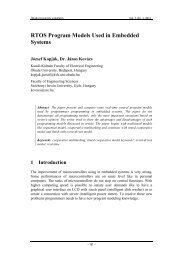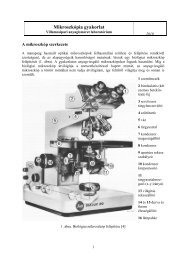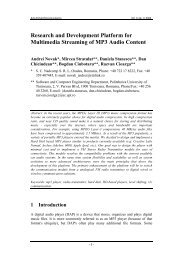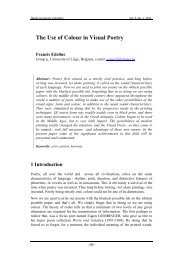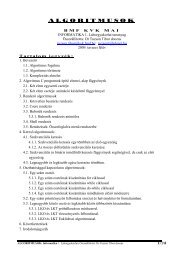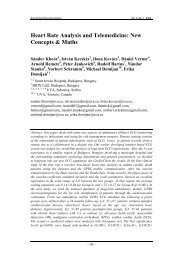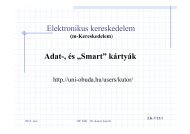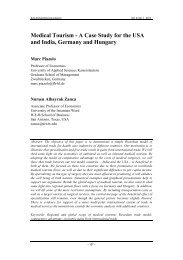Twin Concept of Fine Structure Constant as the 'Self Number ...
Twin Concept of Fine Structure Constant as the 'Self Number ...
Twin Concept of Fine Structure Constant as the 'Self Number ...
Create successful ePaper yourself
Turn your PDF publications into a flip-book with our unique Google optimized e-Paper software.
P. Várlaki et al. <strong>Twin</strong> <strong>Concept</strong> <strong>of</strong> <strong>Fine</strong> <strong>Structure</strong> <strong>Constant</strong> <strong>as</strong> <strong>the</strong> ‘Self <strong>Number</strong>-Archetype’ Part I: Observation, …<br />
Pauli’s ma<strong>the</strong>matics w<strong>as</strong> inherently symbolic: “like Galileo, Newton, Kepler,<br />
Pauli h<strong>as</strong> also perceived <strong>the</strong> word <strong>of</strong> <strong>the</strong> manifestation <strong>of</strong> God, which can only be<br />
perceived ma<strong>the</strong>matically. The physical and ma<strong>the</strong>matical symbols human dimension<br />
he w<strong>as</strong> suggesting that <strong>the</strong> psyche, <strong>the</strong> matter are connecting at <strong>the</strong> archetype<br />
level.” [33].<br />
In this c<strong>as</strong>e we can see that <strong>the</strong> 4 random generating or regulating signals (<strong>as</strong> white<br />
noises) via <strong>the</strong> unit circle can be interpreted <strong>as</strong> dynamic „transforming” systems.<br />
This corresponds to <strong>the</strong> a priori specification <strong>of</strong> <strong>the</strong> positions <strong>of</strong> poles and zeros<br />
with respect to <strong>the</strong> unit circle. At <strong>the</strong> same time, <strong>as</strong> we have seen, parametrical<br />
canonization can be b<strong>as</strong>ed on <strong>the</strong> quaternary notion <strong>of</strong> reachability, observability,<br />
controllability and constructability. They are naturally, <strong>the</strong> “realizations” <strong>of</strong> <strong>the</strong><br />
time projections for <strong>the</strong> c<strong>as</strong>es <strong>of</strong> output future and p<strong>as</strong>t <strong>as</strong> well <strong>as</strong> input future and<br />
p<strong>as</strong>t, respectively.<br />
Looking at one <strong>of</strong> Pauli’s favourite topics, we can obtain altoge<strong>the</strong>r 2×4×4=32 different<br />
possibilities, that is, 32 canonical forms <strong>of</strong> <strong>the</strong> random dynamic systems in a<br />
structural system <strong>of</strong> polarity (oppositions). At <strong>the</strong> same time, applying Pauli’s<br />
world view, <strong>the</strong> archetype patterns can be considered probability fields. It is well<br />
known that Pauli tried to expand <strong>the</strong> concept <strong>of</strong> archetype to include probability:<br />
“Thus speaks <strong>of</strong> <strong>the</strong> probability law instead <strong>of</strong> […] ordering factor.” Jung later<br />
accepted this probabilistic concept <strong>of</strong> archetype and archetypal patterns and applied<br />
it frequently in his later writings. Therefore, <strong>the</strong> above-mentioned white<br />
noises can be treated <strong>as</strong> isomorphic, “dynamic” entities <strong>of</strong> <strong>the</strong> suitable probability<br />
fields, which <strong>of</strong> course include <strong>the</strong> abstract control patterns <strong>as</strong> well.<br />
Consequently <strong>the</strong> 32 canonical representations <strong>of</strong> <strong>the</strong> random dynamic systems<br />
can be applied for <strong>the</strong> twin states (state costate) <strong>of</strong> <strong>the</strong> optimal system. If we define<br />
a symbolic “cognitive” (mirroring or twinning) relationship between <strong>the</strong> given<br />
representations <strong>of</strong> <strong>the</strong> twin states, <strong>the</strong>n we can interpret 32×32 relationships. Symbolically<br />
<strong>the</strong>se 32×32 relationships are <strong>the</strong> sine qua non for <strong>the</strong> realization <strong>of</strong> a<br />
synchronistic (optimal), random systems.<br />
This relationship is “anticipated” by Dream 55: “A silver bowl with four cracked<br />
nuts at <strong>the</strong> cardinal points.” Dream 55 is <strong>the</strong> 72 nd in <strong>the</strong> complete dream series. It<br />
is followed by <strong>the</strong> closing and summarizing four dreams with ring, black bird, four<br />
colours, 32 units, etc. The four nuts at <strong>the</strong> four cardinal points could mean 16 versions.<br />
One nut h<strong>as</strong> 8 dominant poles. Consequently, with <strong>the</strong> one nut <strong>as</strong> unit element,<br />
<strong>the</strong> eight poles and 128 = 16 × 8 versions for <strong>the</strong> dominant poles in sum<br />
equal to 137. From ano<strong>the</strong>r point <strong>of</strong> view, <strong>the</strong> possible topological c<strong>as</strong>es <strong>of</strong> 8<br />
dominant poles are 8 × 8 = 64. Thus <strong>the</strong> number <strong>of</strong> all versions is: 64 × 16 = 1024<br />
= 32 × 32. Thus, <strong>as</strong> <strong>the</strong> 72 nd dream, it anticipates <strong>the</strong> structure and essence <strong>of</strong> <strong>the</strong><br />
World Clock dream. It hints at <strong>the</strong> famous (14 th ) “Rubicon” dream <strong>of</strong> Pauli <strong>as</strong><br />
well. In a previous dream (Dream 52), “<strong>the</strong> dreamer h<strong>as</strong> first to go into <strong>the</strong> adjoining<br />
room to crack some nuts.” At <strong>the</strong> same time, <strong>the</strong> nut kernel is entirely isomorphic<br />
(8 corners) with <strong>the</strong> cube (8 corners) and its previously introduced “defini-<br />
– 96 –



